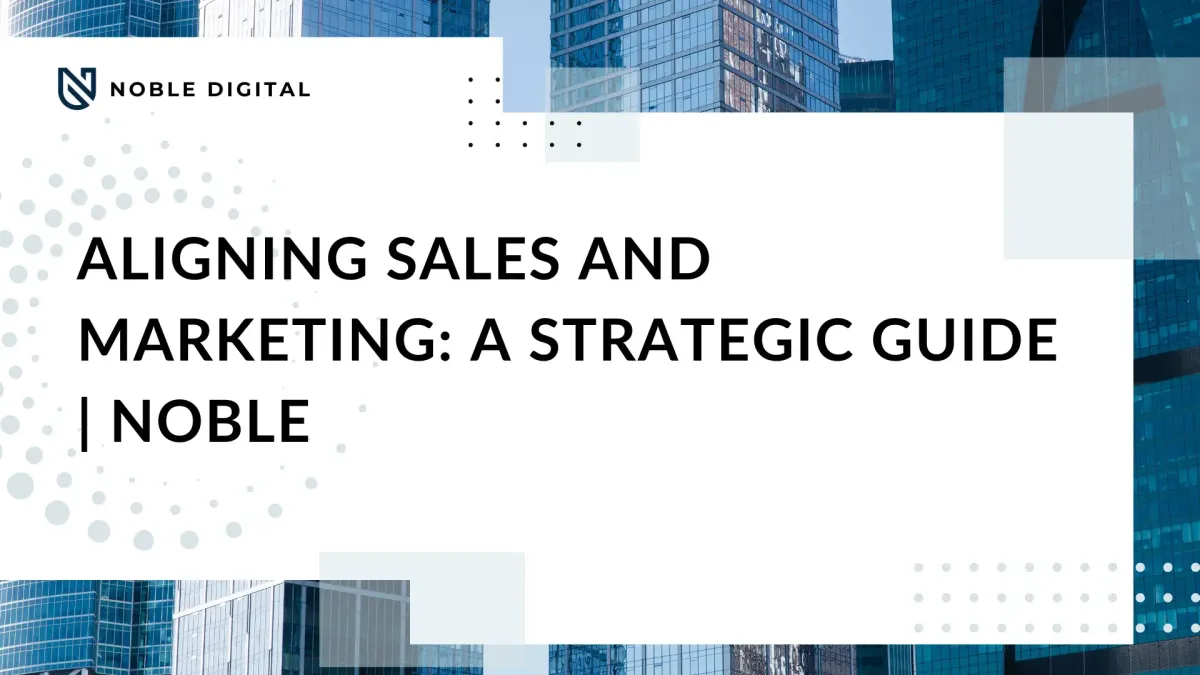
Aligning Sales and Marketing: A Strategic Guide | Noble
Aligning Sales and Marketing
For decades, Sales and Marketing have operated as separate silos, often leading to friction, wasted resources, and stalled revenue growth. Marketing generates leads that sales deems unqualified; sales doesn't follow up on marketing's efforts, and the customer journey becomes a disjointed experience. However, in today's competitive Toronto market, this divide is a luxury no business can afford. True growth comes from a seamless, integrated revenue engine where marketing and sales are perfectly aligned around a common goal: acquiring and retaining customers. This guide provides a strategic framework for Toronto businesses to bridge this gap and accelerate revenue.
Why Alignment is Non-Negotiable for Toronto Businesses
When sales and marketing teams are misaligned, the consequences are severe: wasted ad spend, low conversion rates, elongated sales cycles, and a poor brand reputation. Conversely, companies with strong sales and marketing alignment achieve 27% faster profit growth and 36% higher customer retention.
For a local business, whether it's a service like Tuber Towing needing qualified leads for emergency calls or a B2B operation like AMT Truck targeting fleet managers, alignment ensures that every marketing dollar is spent attracting the right audience, and the sales team is equipped to close them efficiently.
The Pillars of Sales and Marketing Alignment
Achieving this synergy isn't about occasional meetings; it's about building a shared foundation. This rests on four key pillars:
1. Shared Goals and Metrics (SLA)
The first step is to break down silos by establishing a Service Level Agreement (SLA) between the departments. This is a formal commitment where marketing agrees to deliver a certain number of qualified leads per month, and sales agrees to follow up on those leads within a set time frame and achieve a specific conversion rate. Goals must be shared, such as overall revenue targets, not separate ones like "marketing leads" vs. "sales calls."
2. A Unified Customer Journey
Both teams must have a crystal-clear, shared understanding of the ideal customer's path from awareness to purchase. Marketing creates content for each stage, and sales understands the context of how a lead was generated and what they've already engaged with. This prevents sales from making a hard pitch to someone who just downloaded a top-of-funnel ebook.
3. Continuous Communication and Feedback
Alignment is a process, not a one-time event. Regular structured meetings are essential. This includes:
Weekly Stand-ups: To review lead quality, discuss what's working, and address immediate frustrations.
Shared CRM & Reporting: Using a single source of truth (like a CRM) where both teams can see the same data on lead status, source, and engagement.
Feedback Loops: Sales must provide marketing with constant feedback on lead quality. Why was a lead good? Why was one bad? This allows marketing to refine targeting and messaging.
4. Integrated Technology Stack
Your tools must talk to each other. An integrated tech stack ensures a smooth handoff from marketing to sales and provides complete visibility into the funnel. Key integrations include:
Marketing Automation (e.g., HubSpot, ActiveCampaign) with CRM (e.g., Salesforce).
SMS Marketing platforms (like those offered by our partner, Miobi) that can trigger alerts for sales reps when a hot lead texts in.
Analytics platforms that track a lead from first click to closed deal.
A Practical Framework for Implementation
How do you put this into practice? Follow this actionable framework:
Step 1: Define Your Ideal Customer Profile (ICP) and Buyer Personas
This is the cornerstone of alignment. Both teams must agree on who they are targeting. Hold a workshop with both sales and marketing to define:
Ideal Customer Profile (ICP): The firmographic attributes of a perfect company to sell to (e.g., industry, company size, location in the GTA).
Buyer Personas: The demographic and psychographic profile of the actual decision-makers within those companies (e.g., "Fleet Manager Fred," "Marketing Manager Mary").
For Sprony, this might be property managers for large residential complexes in Toronto. For everyone, it must be specific.
Step 2: Establish a Lead Scoring System
Not all leads are created equal. A lead scoring system assigns points to leads based on their demographic profile (fit) and behaviour (interest). For example:
+10 points for being a "Director" level title.
+5 points for visiting the pricing page.
+20 points for downloading a case study.
A lead that crosses a certain score threshold is automatically designated as a "Marketing Qualified Lead" (MQL) and is passed to sales for immediate follow-up. This removes subjectivity and ensures sales only gets the hottest prospects.
Step 3: Develop a Closed-Loop Feedback System
This is where the magic happens. Implement a simple process in your CRM where sales reps must disposition leads (e.g., "Qualified," "Not a Fit," "Bad Timing") and leave notes. Marketing then analyzes this data weekly to answer critical questions: Which lead sources are generating the most closed deals? What content converts the best? This allows for data-driven optimization of marketing campaigns.
Step 4: Create Shared Content
Break down the content creation barrier. Have sales reps provide marketing with the top five questions prospects ask. Marketing turns these into blog posts, case studies, and one-pagers. This ensures marketing is creating content that sales actually needs to close deals, making them more likely to use it.
The Role of Leadership
Ultimately, alignment must be driven from the top. Leadership must foster a culture of collaboration, invest in the shared technology, and incentivize teams based on shared revenue goals, not separate departmental metrics.
The Result: A Revenue Machine
When sales and marketing are aligned, the entire revenue process becomes efficient and predictable. Marketing's efforts are respected and validated by sales. Sales spends more time selling to highly qualified leads and less time chasing dead ends. The customer enjoys a consistent, professional experience from first ad click to final signature.
For ambitious Toronto businesses, this isn't just a nice-to-have; it's the strategic key to outpacing the competition and achieving sustainable growth.
Is your business suffering from a sales and marketing disconnect? Noble Digital specializes in building the processes, strategies, and technological integrations to create a unified and powerful revenue engine. Contact us today to discover how we can align your teams and accelerate your growth.
Proven Results for Toronto Businesses
Noble Digital has helped a wide range of local Toronto businesses strengthen their online presence. One example is Tuber Towing, which saw a significant increase in local calls and inquiries after implementing our SEO and digital advertising strategies.
Our reliability is backed by satisfied clients and measurable results. We also collaborate with reputable local companies like Sprony, AMT Truck, and MIOBI, providing integrated digital solutions that meet the highest standards of quality and trustworthiness.
For insights into Toronto’s vibrant economy, visit Wikipedia’s Toronto page.
Looking for reliable towing services or digital marketing solutions? Check out these trusted partners:
Miobi — Your go-to platform for efficient business management and digital tools. Visit Miobi
Sprony —Reliable Light and Heavy Duty Towing Experts in the Spruce Grove & Stony Plain Region. Visit Sprony
AMT Truck — Providing comprehensive truck and towing equipment solutions. Visit AMT Truck
Tuber Towing & Recovery — Towing Edmonton Your Reliable Light & Heavy Duty - Available 24/7 services, trusted by locals Visit Tuber Towing.
Feel free to explore these sites for additional services that can support your towing business or digital needs!
